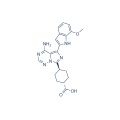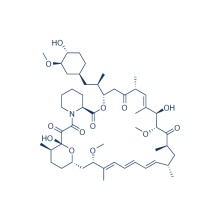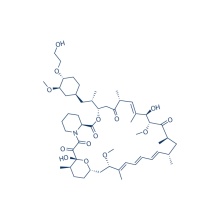.cp_wz tabla {borde superior: 1px sólido #ccc; borde izquierdo: 1px sólido #ccc; } .cp_wz table td {borde derecho: 1px sólido #ccc; borde inferior: 1px sólido #ccc; padding: 5px 0px 0px 5px;} .cp_wz table th {border-right: 1px solid #ccc; border-bottom: 1px solid #ccc; padding: 5px 0px 0px 5px;} \ n Peso molecular: 406.44 OSI-027 es un inhibidor dual selectivo y potente de mTORC1 y mTORC2 con IC50 de 22 nM y 65 nM, y más de 100 veces la selectividad observada para mTOR que PI3Kα, PI3Kβ, PI3Kγ o DNA-PK. Fase 1. \ n OSI-027 muestra las actividades de inhibición selectiva y competitiva de ATP contra mTORC1 y mTORC2 con IC50 de 22 nM y 65 nM, respectivamente. Además, OSI-027 inhibe la señalización de mTOR de fosfo-4E-BP1 con una CI50 de 1 μM en ensayos basados en células. OSI-027 exhibe actividades antiproliferativas contra varias líneas celulares de leucemia aguda de origen mieloide / megacariocítico de una manera dependiente de la dosis, incluidas las células U937, KG-1, KBM-3B, ML-1, HL-60 y MEG-01 . Un estudio reciente muestra que la inhibición de mTORC1 / 2 por OSI-027 suprime eficazmente la fosforilación de Akt (S473) y la proliferación celular en células de cáncer de mama. En el xenoinjerto colorrectal GEO, OSI-027 (65 mg / kg) inhibe los efectores mTORC1 y mTORC2, incluida la fosforilación de 4E-BP1, Akt y S6. Además, la inhibición de mTORC1 y mTORC2 conjuntamente por OSI-027 inhibe de forma potente el crecimiento tumoral más que la inhibición de mTORC1 por rapamicina.
orte
|
Biochemical assays
|
mTORC1 and mTORC2 inhibition is assayed using native enzyme complex immunoprecipitated from HeLa lysates at 1 mM ATP. To prepare whole cell lysates from HeLa cells, 25 g cell pellet is lysed in 60 mL of ice-cold buffer A [40 mM HEPES (pH 7.5), 120 mM NaCl, 1 mM EDTA, 10 mM sodium pyrophosphate, 10 mM glycerophosphate, 50 mM NaF, 0.5 mM orthovanadate, and EDTA-free protease inhibitors containing 0.3% CHAPS] for 30 minutes on a magnetic stirrer in a cold room. After clearing of the lysates by centrifugation at 13,000 g for 10 minutes, Protein G-coated 384-well plates are incubated with 0.25 μg of mTOR antibody in 15 μL of buffer A for 1 hour at 4 °C. To each well, 40 μg of HeLa cell lysate in 15 μL of buffer A is added and incubated overnight at 4 °C to immunoprecipitate mTOR complexes. Plates are washed 3 times with buffer A and twice with immunoprecipitation wash buffer [Buffer B: 50 mM HEPES (pH 7.5) and 150 mM NaCl]. OSI-027 is added at 10 μM concentration to each well and DMSO is added to the control wells. The reaction is started by adding 150 ng of His-tagged 4E-BP1 as a substrate in the presence or absence of 100 μM ATP to each well in 25 μL of freshly prepared kinase buffer [Buffer C: 20 mM HEPES (pH 7.5), 10 mM MgCl2, 4 mM MnCl2, 10 mM β-mercaptoethanol, and 200 μM vanadate] and incubated at room temperature (RT) for 30 minutes. The reaction is stopped by transferring 25 μL of reaction mixture from each well to corresponding wells of fresh Ni-chelate-coated plates and incubated overnight at 4 °C followed by 2 hours at 37 °C. To detect phosphorylation of 4E-BP1, the plates are washed once with TBST (Tris-buffered saline containing 0.1% Tween-20) containing 5% skim milk powder. To each well, 25 μL of 1:1,000 diluted phospho-4E-BP1 antibodies in TBST containing 5% skim milk are added and incubated for 1 hour at RT. The plates are washed once with TBST and then 25 μL of anti-rabbit HRP (diluted 1:10,000) in TBST containing 5% skim milk is added. The plates are incubated for 1 hour at RT and washed 5 times with TBST. For detection of phospho-4E-BP1, 25 μL of chemiluminescent reagents A+B is added and chemiluminescence is measured using an Analyst plate reader.
|
|
Cell lines
|
U937, KG-1, KBM-3B, ML-1, HL-60, and MEG-01
|
|
Concentrations
|
0-10 μM
|
|
Incubation Time
|
72 hours
|
|
Method
|
Inhibition of proliferation is measured using the Cell Titer Glo Assay , as noted in figure legends. To generate dose–response curves, cell lines are seeded at a density of 5,000 cells per well in a 96-well plate. After 24 hours of plating, cells are dosed with varying concentrations of either OSI-027 or rapamycin. The signal for Cell Titer Glo Assay is determined 72 hours after dosing and normalized to that of vehicle-treated controls. Inhibition of proliferation, relative to vehicle-treated controls, is expressed as a fraction of 1 and graphed using PRISM software.
|
|
Animal Models
|
GEO colorectal cells are injected s.c. into the right flank of nu/nu CD-1 mice.
|
|
Formulation
|
Dissolved in DMSO and then diluted in water.
|
|
Dosages
|
≤65 mg/kg
|
|
Administration
|
Administered via gavage.
|
|
Solubility
|
1% DMSO/30% polyethylene glycol/1% Tween 80,
30 mg/mL
|
|
* Please note that Selleck tests the solubility of all compounds in-house, and the actual solubility may differ slightly from published values. This is normal and is due to slight batch-to-batch variations.
|
Conversión de diferentes modelos de animales basados en BSA (valor basado en datos del Borrador de Directrices de la FDA)
|
Species
|
Baboon
|
Dog
|
Monkey
|
Rabbit
|
Guinea pig
|
Rat
|
Hamster
|
Mouse
|
|
Weight (kg)
|
12
|
10
|
3
|
1.8
|
0.4
|
0.15
|
0.08
|
0.02
|
|
Body Surface Area (m2)
|
0.6
|
0.5
|
0.24
|
0.15
|
0.05
|
0.025
|
0.02
|
0.007
|
|
Km factor
|
20
|
20
|
12
|
12
|
8
|
6
|
5
|
3
|
|
Animal A (mg/kg) = Animal B (mg/kg) multiplied by
|
Animal B Km
|
|
Animal A Km
|
Por ejemplo, para modificar la dosis de resveratrol utilizada para un ratón (22,4 mg / kg) a una dosis basada en el BSA para una rata, multiplique 22,4 mg / kg por el factor Km para un ratón y luego divida por el factor Km para una rata. Este cálculo da como resultado una dosis equivalente para ratas de resveratrol de 11,2 mg / kg.
|
Rat dose (mg/kg) = mouse dose (22.4 mg/kg) ×
|
mouse Km(3)
|
= 11.2 mg/kg
|
|
rat Km(6)
|
Información química
|
Molecular Weight (MW)
|
406.44
|
|
Formula
|
C21H22N6O3
|
|
CAS No.
|
936890-98-1
|
|
Storage
|
3 years -20℃Powder
|
|
6 months-80℃in solvent (DMSO, water, etc.)
|
|
Synonyms
|
ASP4786
|
|
Solubility (25°C) *
|
In vitro
|
DMSO
|
18 mg/mL
(44.28 mM)
|
|
Water
|
<1 mg/mL
(
|
|
Ethanol
|
<1 mg/mL
(
|
|
In vivo
|
1% DMSO/30% polyethylene glycol/1% Tween 80
|
30 mg/mL
|
* <1 mg/ml means slightly soluble or insoluble.
* Please note that Selleck tests the solubility of all compounds in-house, and the actual solubility may differ slightly from published values. This is normal and is due to slight batch-to-batch variations.
|
|
Chemical Name
|
(1r,4r)-4-(4-amino-5-(7-methoxy-1H-indol-2-yl)imidazo[1,5-f][1,2,4]triazin-7-yl)cyclohexanecarboxylic acid
|
Calculadora de molaridad Calculadora de dilución Calculadora de peso molecular
Grupos de Producto : PI3K / Akt / mTOR > Inhibidor de mTOR








